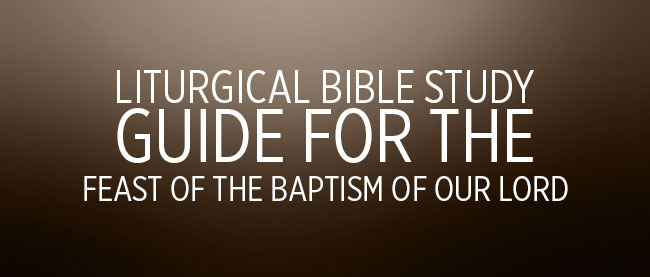Introduction
The feast of the Baptism of The Lord begins a period of time in the liturgical calendar which is called Ordinary Time. During the period of Ordinary Time we are guided through the gospel readings in a chronological manner from the beginning of Jesus’ public ministry through His entry into Jerusalem for His passion, death, and resurrection; an event for which we interrupt the cycle of Ordinary time to celebrate during the Easter season. During Cycle B our gospel readings concentrate on the Gospel of Mark (augmented with selections from the Gospel of John because Mark is so short). Cycle A concentrates on the Gospel of Matthew and Cycle C concentrates on Luke.
Cycle A readings may also be used.
Gospel – Luke 3:15-16, 21-22
Saint Luke devotes only two verses to Jesus’ baptism; and in doing so presents it as an accomplished fact. He spends more time describing the baptism which John the Baptist performed and who is baptized. John is featured as the last of the Old Testament prophets, the one who is to announce the coming of the messiah. Throughout his account, Saint Luke depicts John the Baptist as denying that he is the awaited messiah and as turning the attention of the people from himself to Jesus.
1st Reading – Isaiah 40:1-5, 9-11
The book of Isaiah is not the kind of book which was written all at one time; different parts of it were written at different times over the 50-odd years of Isaiah’s ministry. When the different parts were brought together to form the one book as we know it today is unknown, but we do know from historical evidence that it was in its present form at least as early the 3rd century B.C.
As far as authorship is concerned, Jewish-Christian tradition has always recognized Isaiah as the human author of the entire book. Some modern critics have divided Isaiah into three sections and attempted to ascribe authorship of each section to a different, and later, author. This theory is based on historical and sociological arguments – on the fact that the book refers to events which occurred after Isaiah’s lifetime, which in effect means questioning his prophetic abilities.
After the Psalms, Isaiah is the Old Testament book which is most quoted in the New Testament: 22 quotations and 13 references, and all referring to Isaiah by name. Our reading for today opens with five of the seven verses of the second suffering servant song of Isaiah. The suffering servant songs portray the ideal Servant of God, the perfect Israelite, whose consecration to the divine will, even in the midst of overwhelming suffering “takes away the sins of many” (Isaiah 53:12). This second suffering servant song is addressed to the Gentile nations and presents the servant as another Jeremiah: he is called from his mother’s womb (Jeremiah 1:5); has a vocation to the Gentiles (Jeremiah 1:10; 25:1); brings a message of both doom and happiness (Jeremiah 16:19-21), of both suffering and purification (Jeremiah 11:18-12:6); and he reacts at times with heavy discouragement (Jeremiah 14:17; 20:7). Our reading today then closes with a proclamation of the wondrous reversal of Israel’s fortune. Pre-Christian Judaism gave a messianic interpretation to the suffering servant songs, but it was Jesus Himself who clearly identified Himself as the Servant.
2nd Reading – Titus 2:11-14; 3:4-7
Titus was the bishop ordained by Saint Paul on the island of Crete. This letter, believed to have been written around the year 65 while Saint Paul was in Macedonia, expresses worry about the damage being done by false teachers; teachers who have “a morbid disposition for arguments and verbal disputes” (1 Timothy 6:4). It is generally believed that these false teachers were Judaizing Christians who were using verses of the Old Testament (the only Scriptures possessed by the early Church) out of context to lead people astray. In response to this, Saint Paul reminds Titus of the need for “sound doctrine” and for the necessity of guarding the deposit of faith, the “truth which has been entrusted to you” (the oral Tradition of the New Testament, none of which has been canonized as yet).


